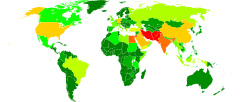Main Core
Main Core is an alleged American government database containing information on those believed to be threats to national security.[1]
 National Security Agency surveillance |
|---|
 |
|
Programs
|
|
Institutions
|
|
Lawsuits
|
|
Whistleblowers
|
|
Publication
|
|
Related
|
History
The existence of the database was first asserted in May 2008 by Christopher Ketcham[2] and again in July 2008 by Tim Shorrock.[3]
In 2018, after a FOIA request to release information about Main Core, the Department of Homeland Security replied that there were no "maincore" or "main core" identified in their records or archives.[4]
Description
The Main Core data, which is believed to come from the NSA, FBI, CIA, and other sources,[1] is collected and stored without warrants or court orders.[1] The database's name derives from the fact that it contains "copies of the 'main core' or essence of each item of intelligence information on Americans produced by the FBI and the other agencies of the U.S. intelligence community".[1]
As of 2008, there were allegedly eight million Americans listed in the database as possible threats, often for trivial reasons, whom the government may choose to track, question, or detain in a time of crisis.[5]
See also
- Rex 84
- FBI Index
- Investigative Data Warehouse
- National Security and Homeland Security Presidential Directive
- NSA warrantless surveillance controversy
- PRISM (surveillance program)
References
- Shorrock, Tim (July 23, 2008). "Exposing Bush's historic abuse of power". Salon.com. Retrieved 2010-12-19.
- Satyam Khanna, "Govt. May Have Massive Surveillance Program for Use in 'National Emergency,' 8 Million 'Potential Suspects'" Archived 2016-04-10 at the Wayback Machine, Think Progress blog, May 20, 2008.
- Goodman, Amy (July 25, 2008). "Main Core: New Evidence Reveals Top Secret". Democracy Now. Retrieved 2010-12-19.
- "DEMA FOIA Case Number 2018-FEFO-00963". Muckrock.com. 30 July 2018. Retrieved 16 October 2019.
- Christopher Ketcham, "The Last Roundup". Archived from the original on August 31, 2008. Retrieved 2008-07-29.CS1 maint: BOT: original-url status unknown (link), RADAR Online, 15 May 2008
External links
- Radar article by Christopher Ketcham, May/June 2008
- NSA's Domestic Spying Grows As Agency Sweeps Up Data by Siobhan Gorman, Updated March 10, 2008 12:01 a.m. ET